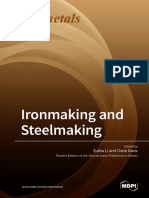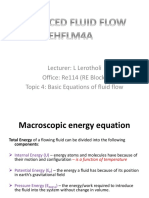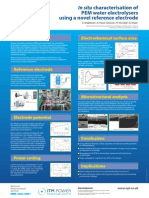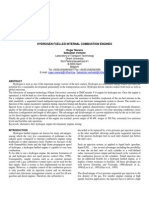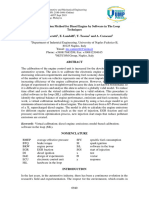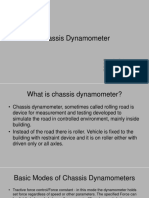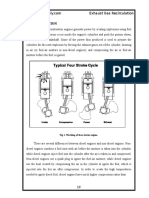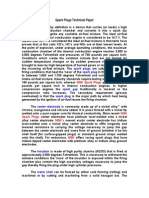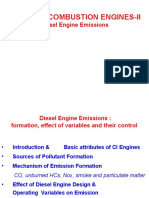Investigating Diesel Engine Performance and Emissions Using CFD
Investigating Diesel Engine Performance and Emissions Using CFD
Uploaded by
mfmechanics2020Copyright:
Available Formats
Investigating Diesel Engine Performance and Emissions Using CFD
Investigating Diesel Engine Performance and Emissions Using CFD
Uploaded by
mfmechanics2020Original Title
Copyright
Available Formats
Share this document
Did you find this document useful?
Is this content inappropriate?
Copyright:
Available Formats
Investigating Diesel Engine Performance and Emissions Using CFD
Investigating Diesel Engine Performance and Emissions Using CFD
Uploaded by
mfmechanics2020Copyright:
Available Formats
Energy and Power Engineering, 2013, 5, 171-180
http://dx.doi.org/10.4236/epe.2013.52017 Published Online March 2013 (http://www.scirp.org/journal/epe)
Investigating Diesel Engine Performance and Emissions
Using CFD
Tarek M. Belal1, El Sayed M. Marzouk2, Mohsen M. Osman1
Department of Mechanical Engineer, Alexandria University, Alexandria, Egypt
Department of Mechanical Engineering, Umm Al-Qura University, Makka, KSA
Email: tarek.belal@eg.bureauveritas.com, emmarzouk@yahoo.com, mohsen7351@yahoo.com
2
Received November 23, 2012; revised December 22, 2012; accepted January 7, 2013
ABSTRACT
Fluid flow in an internal combustion engine presents one of the most challenging fluid dynamics problems to model.
This is because the flow is associated with large density variations. So, a detailed understanding of the flow and combustion processes is required to improve performance and reduce emissions without compromising fuel economy. The
simulation carried out in the present work to model DI diesel engine with bowl in piston for better understanding of the
in cylinder gas motion with details of the combustion process that are essential in evaluating the effects of ingesting
synthetic atmosphere on engine performance. This is needed for the course of developing a non-air recycle diesel with
exhaust management system [1]. A simulation was carried out using computational fluid dynamics (CFD) code FLUENT. The turbulence and combustion processes are modeled with sufficient generality to include spray formation, delay
period, chemical kinetics and on set of ignition. Results from the simulation compared well with that of experimental
results. The model proved invaluable in obtaining details of the in cylinder flow patterns, combustion process and
combustion species during the engine cycle. The results show that the model over predicting the maximum pressure
peak by 6%, (p-), (p-v) diagrams for different engine loads are predicted. Also the study shows other engine parameters captured by the simulation such as engine emissions, fuel mass fraction, indicated gross work, ignition delay period
and heat release rate.
Keywords: Numerical Simulation; Unsteady Flow; Combustion; Diesel Engine
1. Introduction
The requirement to meet the challenge of producing
cleaner and more efficient power plants will intensify
further over the next few years. This challenge requires
an increased commitment to research by the transportation industry. The internal combustion engine represents
one of the more challenging fluid mechanics problems to
model because the flow is compressible with large density variations, relatively high Mach number, turbulent,
unsteady, cyclic, and non-stationary, both spatially and
temporally. Much progress has been made in CFD model
development for engines in recent years.
Clean diesel engines are one of the fuel efficient and
low emission engines of interest in the automotive Industry. The combustion chamber flow field and its effect on
fuel spray characteristics plays an important role in improving the efficiency and reducing the pollutant emission in a direct injection diesel engine, in terms of influencing processes of breakup, evaporation mixture formation, ignition, combustion and pollutant formation. CFD
modeling is a valuable tool to acquire detailed information about these important processes. In this context [2],
Copyright 2013 SciRes.
the characteristics of ultra-high injection pressure diesel
fuel sprays are simulated and validated in a quiescent
constant volume chamber. A profile function is utilized
in order to apply variable velocity and mass flow rate at
the nozzle exit. The CFD model is also applied to an
open cycle engine model to study the effects of engine
flow field features such as swirl and tumble motions on
the spray behavior [2].
A multi-zone direct-injection (DI) diesel combustion
model has been implemented for full cycle simulation of
a turbocharged diesel engine [3]. The above combustion
model takes into account the following features of the
spray dynamics:
the detailed evolution process of fuel sprays;
interaction of sprays with the in-cylinder swirl and the
walls of the combustion chamber;
the evolution of a Near-Wall Flow (NWF) formed as
a result of a spray-wall impingement as a function of
the impingement angle and the local swirl velocity;
interaction of Near-Wall Flows formed by adjacent
sprays;
the effect of gas and wall temperatures on the evapoEPE
172
T. M. BELAL ET AL.
ration rate in the spray and NWF zones.
A NOx calculation sub-model uses detailed chemistry
analysis which considers 199 reactions of 33 species. A
soot formation calculation sub-model used is the phenomenological one and takes into account the distribution of the Sauter Mean Diameter in injection process.
The ignition delay sub-model implements two concepts.
The first concept is based on calculations using the conventional empirical equations. In the second approach the
ignition delay period is estimated using relevant data in
the calculated comprehensive 4-D map of ignition delays.
The model has been validated using published experimental data obtained on high- and medium-speed engines.
Comparison of results demonstrates a good agreement
between theoretical and experimental sets of data [3].
By separating the fluid dynamic calculation from that
of the chemistry, the unsteady flamelet model allows the
use of comprehensive chemical mechanisms, which include several hundred reactions. This is necessary to describe the different processes that occur in a DI Diesel
engine such as auto ignition, the burnout in the partially
premixed phase, the transition to diffusive burning, and
formation of pollutants like NOx and soot. The experimental results show good agreement for the whole combustion cycle (ignition delay, maximum pressures, torque
and pollutant formation) between the two-component reference fuel and Diesel. The simulations are performed
for both reference fuels and are compared to the experimental data. Pollutant formation (NOx and soot) is predicted for both reference fuels. The contributions of the
different reaction paths (thermal, prompt, nitrous, and reburn) to the NO formation are shown. Finally, the importance of the mixing process for the prediction of soot
emissions is discussed [4].
The KIVA code is widely used for model development
in academia due to the availability of the source. However, its capability for resolving complex geometries is
limited.
The KIVA engine simulation developed by Los Alamos National Laboratory was used to characterize the
combustion of alternative fuels in a direct injection diesel
engine. Rapeseed oil, its methyl ester and hexadecane
were used in engines run at 3000 rev/min and 50% maximum torque. Approximately 40 consecutive cycles were
phase averaged to derive the pressure traces for comparison to KIVA predictions. The engine parameters and
the fuel properties used in the simulations are described.
Simulation results were good for the methyl ester and for
hexadecane which was used as a reference fuel. The model predicted lower pressures for the rape oil than those
which were experimentally observed [5].
A modified CFD code based on the KIVA family of
codes incorporating several strategies for reducing the
computational time required for diesel engine simulations
Copyright 2013 SciRes.
is presented. The improved code and coarse meshes are
used together to simulate combustion in a heavy-duty
Mitsubishi Heavy Industries diesel engine operated over
a range of loads, speeds, and injection strategies. The average simulation time from IVC to EVO is reduced from
around 60 hours to 1 hour through the use of 12 processors and the new strategies [6].
On the other hand, other commercial CFD codes such
as STAR-CD, FIRE, VECTIS and FLUENT are frequently
used by industry due to their superior mesh generation
interfaces and because of their available user support.
Some scientists combined STAR-CD and KIVA code for
the engine simulations but they concluded that, it would
be preferable to implement the advanced sub models directly into one commercial code for engine simulations
[7].
The gas motion inside the engine cylinder plays a very
important role in determining the thermal efficiency of
an internal combustion engine. A better understanding of
in cylinder gas motion will be helpful in optimizing engine design parameters. An attempt has been made to
study the combustion processes in a compression ignition
engine and simulation was done using computational fluid
dynamic (CFD) code FLUENT, Turbulent flow modeling
and combustion modeling was analyzed in formulating
and developing a model for combustion process [8].
This paper describes the development and use of sub
models for combustion analysis in direct injection (DI)
diesel engine. In the present study the Computational
Fluid dynamics (CFD) code FLUENT is used to model
complex combustion phenomenon in compression ignition (CI) engine. The results obtained from modeling
were compared with experimental investigation. Consequences in terms of pressure, rate of pressure rise and
rate of heat release are presented. The rate of pressure
rise and heat release rate were calculated from pressure
based statistics. The modeling outcome is discussed in
detail with combustion parameters. The results presented
in this paper demonstrate that, the CFD modeling can be
the reliable tool for modeling combustion of internal combustion engine [9].
2. Scope of Present Work
It is evident from the foregoing discussion that multidimensional calculations for the in cylinder flows are proved
to be powerful tool for diesel engines simulation. A three
dimensional model has been chosen for this investigation.
The turbulence model and combustion model has been
taken for analysis. The turbulence and combustion processes are modeled with sufficient generality to include
spray formation, delay period, chemical kinetics and on
set of ignition. Also the model predicts NO and soot
emissions over a wide range of operating conditions in a
diesel engine.
EPE
173
T. M. BELAL ET AL.
3. Mathematical Description
3.1. Mesh and Boundaries
The mathematical models in CFD start with combustion
chamber geometry approximation representation (engine
mesh) and boundaries types. The geometry can be made
using the pre-processor as shown in Figure 1. The gambit software (pre-processor is used to build and meshing
a model [10]. Table 1 shows engine data [11,12].
3.2. Numerical Modeling
The physical phenomena of combustion flows in internal
combustion engines are very complex, this study uses Eulerian and Lagrangian equations in Fluent code to solve
the gas and liquid phases governing equations [10]. The
gas governing equations consist of mass, momentum,
energy, species, turbulent equation, and chemical reaction. The liquid fuel governing equations contain the
equation of motion, the droplet energy, and spray equations. Regarding the physical boundary conditions, velocity at wall is approximated by turbulent law-of-the-wall
velocity and temperature at wall prescribed by fixed temperature (cylinder head = 490 K, cylinder wall = 473 K
and piston and piston bowl = 550 K. The program starts
at CA = 239 CA at inlet valve close with inlet charge
already fill the cylinder and ends at CA = 469 CA at exhaust valve opening. That means the simulation is counting for the indicated gross work and associated combustion parameters. The simulation is based on the experimental work using the DI diesel engine F1L511 [13].
The present model uses standard k- model for solving
Navier stokes equations employing the eddy dissipation
concept.
3.2.1. Modeling Basic Fluid Flow
It is often required to model a region of the engine as an
open thermodynamic system. Such model is appropriate
when the gas inside the open system boundary can be
assumed uniform in composition and state at each point
in time, and when that state and composition vary with
time due to heat transfer, work transfer, mass flow across
the boundary, and boundary displacement. Governing
equations are mass, momentum equations and energy
equations. These equations for open system, with time or
crank angle as the independent variable, are the building
blocks for thermodynamic based models.
Continuity equation:
v Sm
t
(1)
Momentum equation:
v vv p g F
t
Figure 1. Engine combustion chamber mesh.
Table 1. F1L511 Engine Data.
Type
Duetz F1L511
Operating principle
Four stroke
Number of cylinders
One cylinder
Type of injection
Direct injection
Bore
100 mm
Stroke
105 mm
Swept volume
825 cm3
Compression ratio
17:1
Cooling system
air cooled
Piston crown
Bowl in piston
Injection pressure
175 Bar
Injection duration
26 CA
Copyright 2013 SciRes.
(2)
3.2.2. Heat Transfer Modeling
The energy equation solved is taking the following form:
E v E p
t
keff T j h j J j eff v S h
(3)
The first three terms on the right-hand side of Equation
(3) represent energy transfer due to conduction, species
diffusion, and viscous dissipation, respectively. Sh includes
the heat of chemical reaction, and any other volumetric
heat sources may be defined.
3.2.3. k- Model
The k- model is the simplest complete model of turbulence consists of two-equation model. It is a semiEPE
174
T. M. BELAL ET AL.
Yig
empirical model, and the derivation of the model equations rely on phenomenological considerations and empiricism [14].
k kui
t
xi
t k
Gk Gb YM Sk
xi
k x j
G2
2
k
(4)
id
C1 0.22 S p
6N
(5)
du p
dt
3.2.4. Combustion Modeling
The ignition/combustion model is based on a modified
eddy dissipation concept (EDC) which has been implemented into the CFD code. Multiple simultaneous chemical reactions can be modeled, with reactions occurring in
the bulk phase (volumetric reactions) and/or on wall surfaces. The conservation equation takes the following general form:
a Cn H m b O 2 cN 2
eH 2 fCO gCO 2 hH 2 O jN 2
Zeldovich mechanisms [8]:
O N 2 N NO
O 2 N O NO
N OH H NO
The equilibrium reactions are:
H 2 2H
O 2 2O
N 2 2N
O 2 H 2 2OH
CO O 2 CO 2 O
H 2 O O 2OH
3.2.5. Engine Ignition Modeling
For the present study the Auto-ignition model (Hardenburg model) [16] is the most suitable one for simulating
direct injection Diesel engine. The transport equation for
an ignition species, Yig is given by:
Copyright 2013 SciRes.
FD u u p
gx p
Fx
(9)
3.2.7. Spray Modeling
In the present study the collision model along with the
TAB breakup model are used [17-19].
2.4 f
bcrit r1 r2 min 1.0
We
(6)
It is assumed that reaction occurs in small turbulent
structures, called the fine scales [15]. The bulk reaction is
assumed to be:
ep
1
1 21.2
exp Ea
RT 17,190 p 12.4
(8)
3.2.6. Discrete Phase Modeling
The Lagrangian discrete phases model in the CFD code
follows the Euler-Lagrange approach. For x-direction it
takes the following form
Yi vYi J i Ri Si
t
(7)
The ignition delay period is calculated using the Hardenburg and Hase correlation [9] which is given by:
and
ui
t
xi
t
G1 Gk C3 Gb
xi
k
x j
vYig t Yig Sig
t
Sct
Wec
dy dt n
(10)
(11)
3.2.8. Emissions Modeling
In the present study the mass transport equation for the
NO species is solved, taking into account convection,
diffusion, production and consumption of NO and related
species.
YNO vYNO DYNO S NO
t
(12)
For soot formation the two-step Tesner model is used
[20]. The model predicts the generation of radical nuclei
and then computes the formation of soot on these nuclei.
vbnuc
t bnuc
bnuc
Rnuc (13)
t
nuc
Rsoot Rsoot,form Rsoot,comb
(14)
4. Results and Analysis
4.1. Grid Analysis
The computational grids of the DI diesel engine are
showed in Figure 1. The present study model is build using approximate 200,000 unstructured mixed cells types
(hexagonal and tetrahedral) the grid is divided into two
EPE
T. M. BELAL ET AL.
175
zones. The first zone is the cylinder zone and the second
is the bowl zone. The first zone uses the hexagonal cells
and the second zone uses tetrahedral cells as shown in
Figure 1. In engine operation, valves and the piston move,
so the mesh should move according to the real engine in
order to simulate the charge of valve and piston position
with crank angle. Piston and piston bowl movement are
decided by the stroke, connecting rod and crank angle.
Simulation starts at 239 CA and ends at 469 CA. This
is the period from the inlet valve closing till exhaust
valve opening. That means thermodynamically; the compression stroke and power stroke only accounted in this
study (indicated gross work). The simulation time step is
0.5 crank angles. Each computer run spends about 12
hours on IBM compatible computer using quad duo processor with 2 GHz and 4 MB cache and 6 GB RAM. The
simulation uses fixed temperature boundary conditions
[21] and the initial conditions driven from the experimental work [13].
4.2. Model Validation
Figure 2 shows the comparison of the measured and predicted cylinder pressures. The ignition model scaling factor tuned for the first case (maximum load simulation)
and kept constant in all cases (other load simulated). The
ignition point in most cases is nearly captured. The peak
pressure and the pressure gradient over the combustion
period produced by CFD simulation match closely with
measurements. The peak cylinder pressure is over predicated by about 6%. Figures 3-6 demonstrate the in-cylinder processes reproduced by CFD simulation using a
series of distribution plots illustrating temperature, pressure, fuel mass fraction and gas velocity across the cylinder center plan respectively.
Figure 2. Comparison of the measured and predicted incylinder pressures.
4.3. Engine Performances
The engine performance at different loads is shown in
Figure 7. The figure shows the predicted performance
from maximum load till the no load. From the pressurecrank angle diagram the peaks pressure at different loads
are determined, also the start of injection, start of ignition
is observed. Figure 8 shows p-v diagram which is not
closed, because the simulation period did not reach to the
end of expansion stroke at exhaust valve opening.
Figure 9 shows predicted rate of heat release. The
curve accurately and clearly determined the different combustion zones and delay time period.
The start of injection crank angle is determined from
[13] and the injection period is determined from [11,12].
The delay time period is determined to be from the start
of injection till the p- change its slope as identified in
Figure 9. This period is nearly 11 crank angles vary according to the (equivalence ratio) or load. Figure 10
Copyright 2013 SciRes.
Figure 3. Temperature distribution in (K) at = 0.556, CA
= 339 (maximum load).
shows the predicted heat release along with the predicted
engine pressure at maximum load. From Figure 10 we
can get that the total burning period is much longer than
the injection period, also the magnitude of the initial
peak of the burning rate depends on the ignition delay
period; that means increasing delay period will increase
burning rate peak [22]. Figure 11 illustrates the relative
EPE
176
T. M. BELAL ET AL.
Figure 4. Pressure distribution in (Bar) at = 0.556, CA =
339 (maximum load).
Figure 6. Gas velocity magnitude (m/s) at = 0.556, CA =
339 (maximum load).
Figure 5. C10H22 mass fraction at = 0.556, CA = 345
(maximum load).
magnitude of the gross and net heat release, heat transfer
and heat of vaporization and heating up of the fuel at
1500 RPM for the base line engine. The heat release analysis method [23] is used to obtain the combustion information from the pressure data. The net heat release is
the gross heat release due to combustion extracts from it,
the heat transfer to the walls (omitting the crevice effect)
and the effect of fuel vaporization and heat up. The energy
change associated with heating up fuel vapor from injection temperature to typical compression air temperature
is about 6% of the fuel heating value. The heat transfer
integrated over the duration of the combustion period is
about 35% of the total heat release. The small kink in the
lower part of the curve shows the heat of vaporization
Copyright 2013 SciRes.
Figure 7. Pressure-crank angle at different engine loads.
and heating up fuel.
Figure 12 shows the predicted temperature-crank angle diagram at different loads. The curve shows that increasing the load which corresponding to increasing the
fuel mass flow rate results in increasing the combustion
temperature. Figure 12 shows that the temperature of the
air at the end of compression is sufficiently high for the
droplets of fuel to vaporize and ignite as they enter the
cylinder. Very small downward kinks found near fuel inEPE
T. M. BELAL ET AL.
177
Figure 10. Predicted rate of heat release and engine cylinder
pressure at full load.
Figure 8. Pressure-volume diagram at different loads.
Figure 11. Predicted grows and net heat Release profile
during combustion at 1500 RPM.
Figure 9. Predicted rate of heat release diagram identifying
different diesel combustion phases at maximum load.
jection crank angle represent the interaction between the
liquid fuel (heated up) and the air in the cylinder (cooled).
4.4. Emissions
Engine emissions due to combustion of hydrocarbon fuel
depend on the combustion equations and the emission
model solved to calculate engine pollutant. In the present
study the combustion emissions CO, CO2, NO and Soot
are calculated. Figure 13 shows NO concentrations rise
from the residual gas value following the start of combustion, to a peak at the point where the burned gas equiCopyright 2013 SciRes.
Figure 12. Temperature-crank angle diagram.
valence ratio changes from rich to lean (where the CO
and CO2 concentration has its maximum value).
As the burned gas equivalence ratio becomes leaner
due to mixing with excess air, NO concentrations decrease since formation becomes much slower as dilution
occurs.
EPE
178
T. M. BELAL ET AL.
of Diesel Engine CFD Simulations, International Multidimensional Engine Modeling Users Group Meeting, SAE
Congress, 23 April 2012
Figure 13. Concentration of Soot, NO and CO for different
loads as a function of crank angle.
5. Conclusions
From the present study the main conclusions are:
The fluid flow in DI diesel having bowel in piston
with turbulence and combustion processes modeled
with sufficient generality to include spray formation,
delay period, chemical kinetics and onset of ignition;
adequately simulated the engine cycle.
The model is validated through the comparison of the
predicted p- curve with the experimental p- curve.
Some important engine characteristics are predicted
such as heat release rate, gross and net heat release. In
addition the T- diagrams for different loads are shown.
Detailed CFD model predictions are obtained as incylinder temperature and pressure distributions, gas
velocity and fuel mass fraction on the piston bowl.
REFERENCES
[1]
[2]
G. T. R. Reader, M. Zheng, I. J. Potter and J. G. Hawley,
Investigation of Non-Air Diesel Engine Systems, 28th
Inter-Socity Energy Conversion Engineering Conference,
San Diego, 1992.
K. Fukuda, A. Ghasemi, R. Barron and R. Balachandar,
An Open Cycle Simulation of DI Diesel Engine Flow
Field Effect on Spray Processes, SAE Technical Paper
2012-01-0696, 2012. doi:10.4271/2012-01-0696
[3]
A. S. Kuleshov, Multi-Zone DI Diesel Spray Combustion Model for Thermodynamic Simulation of Engine
with PCCI and High EGR Level, SAE Paper No 200901-1956, 2009.
[4]
H. Barths, H. Pitsch and N. Peters, 3d Simulation of Di
Diesel Combustion and Pollutant Formation Using a TwoComponent Reference Fuel, Oil & Gas Science and Technology, Vol. 54, No. 2, 1999.
[5]
L. V. Griend, M. E. Feldman and C. L. Peterson, Modeling Combustion of Alternate Fuels in a DI Diesel Engine
Using KIVA, ASAE, Vol. 33, No. 2, 1990, pp. 342-350.
[6]
B. A. Cantrell, R. D. Reitz, C. J. Rutland and Y. Immamori, Strategies for Reducing the Computational Time
Copyright 2013 SciRes.
[7]
S. A. Basha and K. R. Gopal, In-Cylinder Fluid Flow Turbulence and Spray Models, Renewable and Sustainable
Energy Reviews, Vol. 13, No. 6-7, 2008, pp. 1620-1627.
[8]
S. M. Jameel Basha, P. Issac Prasad and K. Rajagopal,
Simulation of In-Cylinder Processes in a DI Diesel Engine with Various Injection Timings, ARPN Journal of
Engineering and Applied Sciences, Vol. 4, No. 1, 2009.
[9]
U. V. Kongre and V. K. Sunnapwar, CFD Modeling and
Experimental Validation of Combustion in Direct Ignition
Engine Fueled with Diesel, International Journal of Applied Engineering Research, Vol. 1, No. 3, 2010.
[10] Fluent-ANSYI, FLUENT 6.3.26. 2006. Users Manual
and Tutorial Guide, Fluent Inc., 2006.
[11] KHD Deutz, FL 511/W Instruction Manual, 2973544D/
E, 2000.
[12] Oruva Motor, F1L511 Diesel Engine Technical Data,
Licensed from Dutez, 2000.
[13] A. M. Nour, E. M. Marzouk, A. A. Abel Rahman and W.
A. Abdel Ghafar, Effect of Carbon Dioxide in Non-Air
Inlet Mixture on Combustion performance in Diesel Engine, IREME, 2009
[14] B. E. Launder and D. B. Spalding, Lectures in Mathematical Models of Turbulence, Academic Press, London,
1972.
[15] B. F. Magnussen, On the Structure of Turbulence and a
Generalized Eddy Dissipation Concept for Chemical Reaction in Turbulent Flow, Nineteenth AIAA Meeting, St.
Louis, 1981.
[16] H. O. Hardenburg and F. W. Hase, An Empirical Formula for Computing the Pressure Rise Delay of a Fuel
from Its Cetane Number and from the Relevant Parameters of Direct Injection Diesel Engines, SAE Technical
Paper 790493, SAE, 1979.
[17] P. J. ORourke and A. A. Amsden, The TAB Method for
Numerical Calculation of Spray Droplet Breakup, SAE
Technical Paper 872089, SAE, 1987.
[18] R. D. Reitz, Mechanisms of Atomization Processes in
High-Pressure Vaporizing Sprays, Atomization and Spray
Technology, Vol. 3, No. 4, 1987, pp. 309-337.
[19] R. D. Reitz and F. V. Bracco, Mechanisms of Breakup
of Round Liquid Jets, The Encyclopedia of Fluid Mechanics, Vol. 3, 1986, pp. 223-249.
[20] P. A. Tesner, T. D. Snegiriova and V. G. Knorre, Kinetics of Dispersed Carbon Formation, Combustion and
Flame, Vol. 17, No. 2, 1971, pp. 253-260.
doi:10.1016/S0010-2180(71)80168-2
[21] J. F. Wiedenhoefer and R. D. Reitz, Multidimensional
Modeling of the Effects of Radiation and Soot Deposition
in Heavy-Duty Diesel Engines, SP-1740 SAE 2003-010560, 2003, pp. 251-271.
[22] G. L. Borman and K. W. Ragland, Combustion Engineering, WCB, McGraw-Hill, 1998.
[23] J. B. Heywood, Internal Combustion Engine Fundamentals, McGraw Hill, New York, 1988.
EPE
T. M. BELAL ET AL.
179
Nomenclature
20%, 80%
A
*
bnuc
Engine loads percentage
Amplitude
bcrit
C1
C1 , C2
C10H22
CA
CFD
CO
CO2
D
DI
EDC
Ea
ep
E
Exp
Fraction of max. volume
F
FD(u up)
Fx
f
Gb
gi
Gk
Critical droplet offset
Constant 0.36
Constants 1.44, 1.92 respectively
Diesel fuel
Crank Angle
Computational fluid dynamics
Carbon monoxide
Carbone dioxide
effective diffusion coefficient (m2/s)
Direct injection
Eddy dissipation concept
Fuel effective activation energy (J/kgmole)
pressure exponent
Flow energy (J/kgmole)
Experimental
Volume fraction of current cylinder volume to maximum cylinder volume
external body forces (N)
Drag force per unit particle mass (N/kg)
External force in x-direction
Droplet radius function (r1, r2)
turbulence kinetic energy due to buoyancy (m2/s2)
Component of the gravitational vector in the ith direction (N)
turbulence kinetic energy due to the mean velocity gradients (m2/s2)
Hydrogen
Heat Release Rate (kJ/kg)
Water
H, H2
HHR
H2O
JJ
normalized radical nuclei concentration (particles 1015/kg)
diffusion flux of species j (kg/(m2/s))
k
keff
Kr
kt
KIVA
min
N
N2
n
NO
O2,O
OH
p
Prt
Qn
Qch
R
Ri
Rsoot, comb
RPM
Rsoot,form
*
Rnuc
Turbulent kinetic energy (m2/s2)
effective conductivity (W/(mK))
Overall reaction rate constant
turbulent thermal conductivity (W/(mK))
Internal combustion engine simulation code from Los Alamos National laboratory
Minimum function
engine speed in revolutions per minute
Nitrogen
Time step
Nitrogen oxide
Oxygen
Hydroxide
static pressure (Pa)
turbulent Prandtl number for energy
Fuel energy (J/kmole)
Chemical heat release (J/kmole)
Universal gas constant (J/kmoleK)
net rate of production of species i by chemical reaction (kg/(cm3s))
rate of soot combustion (particles/s)
revolution per minutes
rate of soot formation (particles/s)
r1 , r2
Droplet radius
Sct
Turbulent Schmidt number
Copyright 2013 SciRes.
normalized net rate of nuclei generation (particles 1015/m3s)
EPE
180
T. M. BELAL ET AL.
Continued
Si
S k, S
Sm
SNO
Sp
Rate of creation by addition from the dispersed phase plus any user-defined sources
user-defined source terms for k and equations
mass added to the continuous phase from the dispersed second phase (kg)
source term is to be determined for NO mechanism
SOI
to
T
u
up
We
Wec
x
y
Yig
YM
YNO
Start of injection
time at which fuel is introduced into the domain (s)
Temperature
Fluid phase velocity (m/s)
Particle velocity (m/s)
Weber number
Critical Weber number
Displacement in x-direction
Displacement in y-direction
mass fraction of a passive species representing radicals which form when the fuel in the domain breaks down
fluctuating dilatation in compressible turbulence to the overall dissipation rate (kg/(ms2))
mass fraction of NO in the gas phase
Turbulent rate dissipation (m2/s2)
Crank angle
molecular viscosity of the fluid (Ns/m2)
Absolute velocity vector (m/s)
gravitational body force (N)
fluid density (kg/m3)
*
nuc
mean piston speed (m/s)
turbulent Prandtl number for nuclei transport
id
correlation of ignition delay with the units of time (s)
eff
Effective stress tensor (N)
Fuel to air ratio
Angular velocity (rps)
Copyright 2013 SciRes.
EPE
You might also like
- Guidebook - Updated 2019Document109 pagesGuidebook - Updated 2019DK White LionNo ratings yet
- Thermal PhysicsDocument286 pagesThermal PhysicsVishal ParmarNo ratings yet
- Ironmaking and Steelmaking PDFDocument466 pagesIronmaking and Steelmaking PDFakshukNo ratings yet
- CFD Studies of Combustion in Diesel EngineDocument4 pagesCFD Studies of Combustion in Diesel Enginedeepali0305100% (1)
- ME401 Engine PerformanceDocument3 pagesME401 Engine PerformanceHuynh Quoc VietNo ratings yet
- Performance of IC Engine With Bio-DieselDocument10 pagesPerformance of IC Engine With Bio-DieselBilla ManojNo ratings yet
- Chapter 11 Metal AlloysDocument24 pagesChapter 11 Metal Alloyssihar raymondNo ratings yet
- 4.basic Equations of Fluid FlowDocument31 pages4.basic Equations of Fluid FlowMAHLATSE MULALANo ratings yet
- Water Flow in Open Channels: The Islamic University of Gaza Faculty of Engineering Civil Engineering DepartmentDocument74 pagesWater Flow in Open Channels: The Islamic University of Gaza Faculty of Engineering Civil Engineering DepartmentTesfaye NegasaNo ratings yet
- Vinoharan PortfolioDocument162 pagesVinoharan PortfolioPradeep sanjeewaNo ratings yet
- Air-Standard Cycles and Their AnalysisDocument40 pagesAir-Standard Cycles and Their AnalysisSrimanthula Srikanth100% (1)
- YvvyvyDocument120 pagesYvvyvyDK White LionNo ratings yet
- New Ousl GuidDocument35 pagesNew Ousl GuidPrathiesh prathieshNo ratings yet
- CFD Analysis of Di Combustion Chamber of Diesel FinalDocument30 pagesCFD Analysis of Di Combustion Chamber of Diesel FinalGyanMohanSinghNo ratings yet
- CE 421 Open Channel Flow Part-1 (2322)Document37 pagesCE 421 Open Channel Flow Part-1 (2322)Afrahim Chowdhury Fashol 201-47-393No ratings yet
- In Situ Characterisation of PEM Water Electrolysers Using A Novel Reference ElectrodeDocument1 pageIn Situ Characterisation of PEM Water Electrolysers Using A Novel Reference ElectrodeNational Physical LaboratoryNo ratings yet
- IC Engine Exhaust EmissionsDocument35 pagesIC Engine Exhaust EmissionsSrinivasanNo ratings yet
- ICE - Bharat Stage Vs Euro Emission NormsDocument27 pagesICE - Bharat Stage Vs Euro Emission Normsmaa1333No ratings yet
- I C Engines and Fluid Machinery LabDocument39 pagesI C Engines and Fluid Machinery LabranjithkrajNo ratings yet
- H2 Fuelled Internal Combustion EngineDocument8 pagesH2 Fuelled Internal Combustion EnginePRASAD326No ratings yet
- Virtual Calibration Method For Diesel Engine by Software in The Loop Techniques M. C. Cameretti, E. Landolfi, T. Tesone and A. CaraceniDocument18 pagesVirtual Calibration Method For Diesel Engine by Software in The Loop Techniques M. C. Cameretti, E. Landolfi, T. Tesone and A. CaraceniDiep Hau ThanNo ratings yet
- Bharath Stage EmissionsDocument32 pagesBharath Stage EmissionsShrinivaskampelliNo ratings yet
- Diesel Engine - Combustion, Emissions and Condition Monitoring PDFDocument275 pagesDiesel Engine - Combustion, Emissions and Condition Monitoring PDFSamir Alshaar100% (1)
- Presentation On Chasis DynamometerDocument22 pagesPresentation On Chasis DynamometerAjay_BadeNo ratings yet
- SAE Automobile Heat Transfer 2Document281 pagesSAE Automobile Heat Transfer 2sardhan.rajender84100% (1)
- Properties of Mixtures and CombustionDocument7 pagesProperties of Mixtures and CombustionKhairul NajmiNo ratings yet
- Possibilities of Alternative Vehicle Fuels - A Literature ReviewDocument40 pagesPossibilities of Alternative Vehicle Fuels - A Literature ReviewNeha SoniNo ratings yet
- CHAPTER 7 Combustion in SI and CI EnginesDocument47 pagesCHAPTER 7 Combustion in SI and CI EnginesRushabh PatelNo ratings yet
- Ic Engine Performance CharacteristicDocument30 pagesIc Engine Performance CharacteristicAjitKumarPandeyNo ratings yet
- Emission Characteristics and Performance of Catalytic Converter A ReviewDocument8 pagesEmission Characteristics and Performance of Catalytic Converter A ReviewEditor IJTSRDNo ratings yet
- Exhaust Gas Analysis - Part One PDFDocument4 pagesExhaust Gas Analysis - Part One PDFFabricio LimaNo ratings yet
- Automotive Engine Test Bed For Mechanical Engineering Laboratory Course PDFDocument128 pagesAutomotive Engine Test Bed For Mechanical Engineering Laboratory Course PDFAngel OfrenNo ratings yet
- Euro and Bharat Stage Emission NormsDocument23 pagesEuro and Bharat Stage Emission NormsKrishna PrasadNo ratings yet
- Diesel Engine Case Study Cat CriDocument16 pagesDiesel Engine Case Study Cat CriveereshNo ratings yet
- I C Eingiine and EmissionsDocument384 pagesI C Eingiine and EmissionsRanjit RajendranNo ratings yet
- M Tech Thermal and Fluids EngineeringDocument26 pagesM Tech Thermal and Fluids EngineeringSumanNo ratings yet
- Chapter 02Document56 pagesChapter 02Samaria Mitchell100% (9)
- Exhaust Gas Recirculation ReportDocument19 pagesExhaust Gas Recirculation ReportKoushik somayajulaNo ratings yet
- Combustion Data Acquisition and Analysis: Department of Aeronautical and Automotive EngineeringDocument75 pagesCombustion Data Acquisition and Analysis: Department of Aeronautical and Automotive EngineeringKidus DawitNo ratings yet
- 3 - Heat Engines EfficiencyDocument3 pages3 - Heat Engines EfficiencyJestony MatillaNo ratings yet
- 8 Fundamental Equation of Fluid FlowDocument70 pages8 Fundamental Equation of Fluid FlowKit Meng LimNo ratings yet
- Internal Combustion Engines2Document92 pagesInternal Combustion Engines2Rupinder Rp100% (1)
- Adaptive Transmission ControlDocument21 pagesAdaptive Transmission ControlAbdul Shamil M SNo ratings yet
- IC Engine Lab ManualDocument11 pagesIC Engine Lab ManualVyankat Dev Singh100% (1)
- Vehicle Structure and Engines: Two Marks Questions & AnswersDocument8 pagesVehicle Structure and Engines: Two Marks Questions & AnswersThulasi RamNo ratings yet
- CE-2101 Fluid Mechanics: Flow Through Orifices & NotchesDocument45 pagesCE-2101 Fluid Mechanics: Flow Through Orifices & NotchesShaheer Rizwan100% (1)
- AD-II NEW QB FinalDocument79 pagesAD-II NEW QB Finalblack legNo ratings yet
- 4 Defects in Crystalline MaterialsDocument28 pages4 Defects in Crystalline MaterialsschoolNo ratings yet
- Spark Plugs Technical PaperDocument5 pagesSpark Plugs Technical PaperWilliam KibbeNo ratings yet
- Design & Analysis of Individual Exhaust System For Improving Transient Response of A Turbo Diesel EngineDocument15 pagesDesign & Analysis of Individual Exhaust System For Improving Transient Response of A Turbo Diesel EngineSandeep Kr. Mishra100% (1)
- VSD The Impact of Hybrid and Electric Powertrains On Vehicle Dynamics Control Systems and Energy RegenerationDocument18 pagesVSD The Impact of Hybrid and Electric Powertrains On Vehicle Dynamics Control Systems and Energy RegenerationMahmoud AbuziadNo ratings yet
- Mecorrel2 - Thermo-Fluids Terminology PDFDocument13 pagesMecorrel2 - Thermo-Fluids Terminology PDFJohn Paul EspañoNo ratings yet
- Factors Affecting Car Fuel ConsumptionDocument23 pagesFactors Affecting Car Fuel ConsumptionScribd898989100% (1)
- Unit 4Document15 pagesUnit 4SDGFSAGFNo ratings yet
- Internal Combustion Engines & Emissions Revision Questions-Part 1Document6 pagesInternal Combustion Engines & Emissions Revision Questions-Part 1Nbl KlfNo ratings yet
- Internal Combustion Engines-Ii: Diesel Engine EmissionsDocument88 pagesInternal Combustion Engines-Ii: Diesel Engine Emissionsg prashanthNo ratings yet
- Heat Transfer On Internal Combustion EngineDocument23 pagesHeat Transfer On Internal Combustion EngineSatyam kumar UpadhyayNo ratings yet
- Week 1 M-Motronic Systems LectureDocument16 pagesWeek 1 M-Motronic Systems LectureAhmed El-helwNo ratings yet
- Impedance Spectroscopy: Theory, Experiment, and ApplicationsFrom EverandImpedance Spectroscopy: Theory, Experiment, and ApplicationsEvgenij BarsoukovNo ratings yet
- Introductory Applications of Partial Differential Equations: With Emphasis on Wave Propagation and DiffusionFrom EverandIntroductory Applications of Partial Differential Equations: With Emphasis on Wave Propagation and DiffusionNo ratings yet
- 2003 01 1060Document13 pages2003 01 1060Jeremy DiazNo ratings yet
- Computational Fluid Dynamics Expert System Using Artificial Neural NetworksDocument5 pagesComputational Fluid Dynamics Expert System Using Artificial Neural Networksmfmechanics2020No ratings yet
- For Review OnlyDocument23 pagesFor Review Onlymfmechanics2020No ratings yet
- Computer-Aided Solution To The Vibrational Effect of Instabilities in Gas Turbine CompressorsDocument7 pagesComputer-Aided Solution To The Vibrational Effect of Instabilities in Gas Turbine Compressorsmfmechanics2020No ratings yet
- Work Output and Efficiency of A Reversible Quantum Otto CycleDocument8 pagesWork Output and Efficiency of A Reversible Quantum Otto Cyclemfmechanics2020No ratings yet
- Case 1333062148Document106 pagesCase 1333062148mfmechanics2020No ratings yet
- A History of ThermodynamicsDocument95 pagesA History of ThermodynamicsCintia Sofia Pinilla PradaNo ratings yet
- Amu DaDocument9 pagesAmu DaJerry LedesmaNo ratings yet
- 14.6 Ideal Gas Equation - Practice ProblemDocument8 pages14.6 Ideal Gas Equation - Practice ProblemadimeghaNo ratings yet
- Aspects of Lead Acid Battery Technology 6 Designing For Capacity PDFDocument43 pagesAspects of Lead Acid Battery Technology 6 Designing For Capacity PDFtjkiddNo ratings yet
- Micro Flywheel Energy HarvestDocument10 pagesMicro Flywheel Energy HarvestkhayatNo ratings yet
- Vaporization, Dispersion, and Flux LPGDocument189 pagesVaporization, Dispersion, and Flux LPGKonstantinKotNo ratings yet
- Full Length Article: SciencedirectDocument14 pagesFull Length Article: SciencedirectnicolasNo ratings yet
- Utilization of Support Vector Machine To Calculate Gas Compressibility FactorDocument14 pagesUtilization of Support Vector Machine To Calculate Gas Compressibility FactorekeneNo ratings yet
- Technical ReferenceDocument120 pagesTechnical ReferenceMartino RossiNo ratings yet
- Chem 1A Chapter 5 Exercises: Boyle's LawDocument5 pagesChem 1A Chapter 5 Exercises: Boyle's LawSheryll de GuzmanNo ratings yet
- Conduction Notes PDFDocument5 pagesConduction Notes PDFgodaxonNo ratings yet
- Startup Paralel Turbo CompressorDocument24 pagesStartup Paralel Turbo Compressorilmu2No ratings yet
- TRACE 1300 Series New PresentationDocument59 pagesTRACE 1300 Series New Presentationmikicacica100% (1)
- LPG Cargo Measurement and Calculation ProcedureDocument5 pagesLPG Cargo Measurement and Calculation ProcedureJaspal Singh Sahota100% (3)
- Melting and Holding Furnaces For Die CastingDocument11 pagesMelting and Holding Furnaces For Die CastingVAP BOMBAYNo ratings yet
- CDM PDFDocument3 pagesCDM PDFferas_elnggar100% (1)
- Quotation For Oxygen Production System: Equipment Item Oxygen Plant Set PurityDocument10 pagesQuotation For Oxygen Production System: Equipment Item Oxygen Plant Set PurityNaie GyiNo ratings yet
- Syllabus Content 2020-2021 (Term3) : Learning OutcomesDocument6 pagesSyllabus Content 2020-2021 (Term3) : Learning OutcomesЕлнур ИкимбаевNo ratings yet
- Free Alkaline Index Biomass CombustionDocument6 pagesFree Alkaline Index Biomass CombustionmsoyoralNo ratings yet
- CHE+3054S+Solid+Fluid+Reactions+ST+Ver+2+ Print-FriendlyDocument39 pagesCHE+3054S+Solid+Fluid+Reactions+ST+Ver+2+ Print-FriendlynmhatityeNo ratings yet
- An A AlnorDewpointer ManualDocument88 pagesAn A AlnorDewpointer Manualkarla caaroNo ratings yet
- Petroleum Production Engineering Ii: Sucker Rod PumpingDocument27 pagesPetroleum Production Engineering Ii: Sucker Rod PumpingMohammed Khaled Al-ThobhaniNo ratings yet
- TK 411 - Lecture Note 6 - Reactor DesignDocument41 pagesTK 411 - Lecture Note 6 - Reactor DesignramaNo ratings yet
- The Gibbs Phase Rule RevisitedDocument3 pagesThe Gibbs Phase Rule Revisitedleizar_death640% (1)
- A CFD Analysis of Flow Through A High Pressure Natural Gas Pipeline With An Undeformed and Deformed Orifice PlateDocument4 pagesA CFD Analysis of Flow Through A High Pressure Natural Gas Pipeline With An Undeformed and Deformed Orifice PlateArdian20No ratings yet
- Gashydraulic 2Document15 pagesGashydraulic 2egmbrNo ratings yet
- Yeast LabDocument3 pagesYeast LabAlex AlilingNo ratings yet
- Heat Transfer EngineeringDocument12 pagesHeat Transfer EngineeringAliArababadiNo ratings yet


